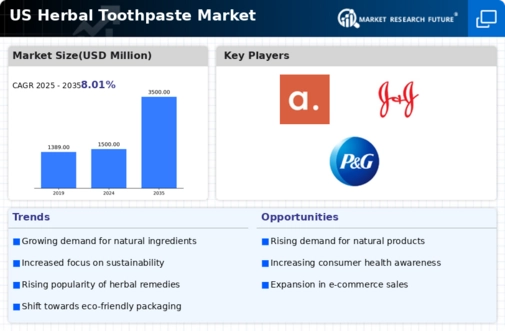Expansion of Retail Channels
The expansion of retail channels is another critical driver for the herbal toothpaste market. As more retailers recognize the demand for natural and organic products, they are increasingly incorporating herbal toothpaste into their offerings. This trend is evident in both brick-and-mortar stores and e-commerce platforms, where the availability of herbal toothpaste has significantly increased. Data suggests that sales through online channels have grown by over 30% in the past year, reflecting a shift in consumer shopping habits. The herbal toothpaste market stands to benefit from this diversification of retail channels, as it enhances product accessibility and visibility. Furthermore, partnerships with health-focused retailers and pharmacies can further bolster market presence, making it easier for consumers to find and purchase herbal toothpaste.
Regulatory Support for Natural Products
Regulatory support for natural products is emerging as a vital driver for the herbal toothpaste market. Government initiatives aimed at promoting the use of natural ingredients in personal care products are likely to foster a favorable environment for the herbal toothpaste market. Recent policy changes have encouraged manufacturers to adopt cleaner formulations, which aligns with consumer demand for transparency and safety. This regulatory landscape not only supports the growth of herbal toothpaste but also instills consumer confidence in the products. As regulations continue to evolve, companies that comply with these standards may gain a competitive advantage, potentially leading to increased market share. The herbal toothpaste market is thus positioned to thrive in an environment that increasingly values natural and safe product offerings.
Rising Demand for Eco-Friendly Products
The growing demand for eco-friendly products is a significant driver for the herbal toothpaste market. Consumers are increasingly concerned about the environmental impact of their purchases, leading to a preference for products that utilize sustainable ingredients and packaging. Research indicates that approximately 65% of consumers are willing to pay a premium for eco-friendly products, which presents a lucrative opportunity for brands in the herbal toothpaste market. Companies that adopt sustainable practices, such as biodegradable packaging and ethically sourced ingredients, are likely to attract environmentally conscious consumers. This trend not only aligns with consumer values but also enhances brand loyalty, as customers are more inclined to support companies that demonstrate a commitment to sustainability. The herbal toothpaste market is thus poised for growth as it adapts to these evolving consumer expectations.
Growing Consumer Awareness of Oral Health
The increasing awareness among consumers regarding oral health is a pivotal driver for the herbal toothpaste market. As individuals become more informed about the implications of oral hygiene on overall health, they are more inclined to seek products that align with their health-conscious lifestyles. This trend is particularly pronounced among millennials and Gen Z, who prioritize natural ingredients and holistic health solutions. According to recent surveys, approximately 70% of consumers express a preference for products that are free from artificial additives. This shift in consumer behavior is likely to propel the demand for herbal toothpaste, as it is perceived as a safer and more effective alternative to conventional options. The herbal toothpaste market is thus positioned to benefit from this heightened focus on health and wellness, potentially leading to increased sales and market penetration.
Influence of Social Media and Digital Marketing
The role of social media and digital marketing in shaping consumer preferences cannot be overstated, particularly in the herbal toothpaste market. Brands are increasingly leveraging platforms like Instagram and TikTok to promote their products, often through influencer partnerships that resonate with younger audiences. This strategy appears to be effective, as studies indicate that nearly 60% of consumers are influenced by social media when making purchasing decisions. The herbal toothpaste market is witnessing a surge in online sales, driven by targeted advertising and engaging content that highlights the benefits of herbal formulations. As more consumers turn to online platforms for product discovery, the potential for growth in this sector is substantial, suggesting that brands that effectively utilize digital marketing strategies may gain a competitive edge.














Leave a Comment